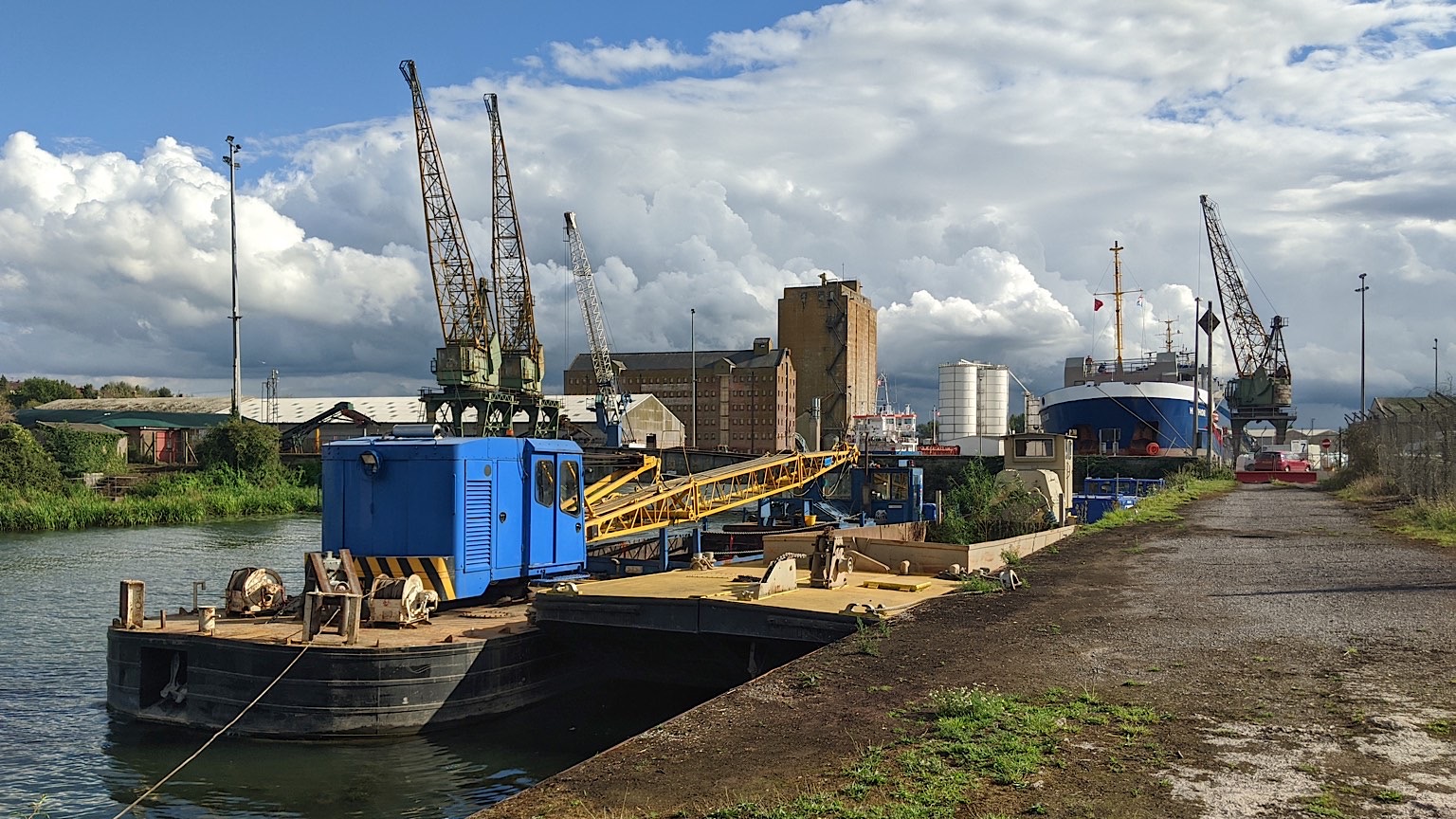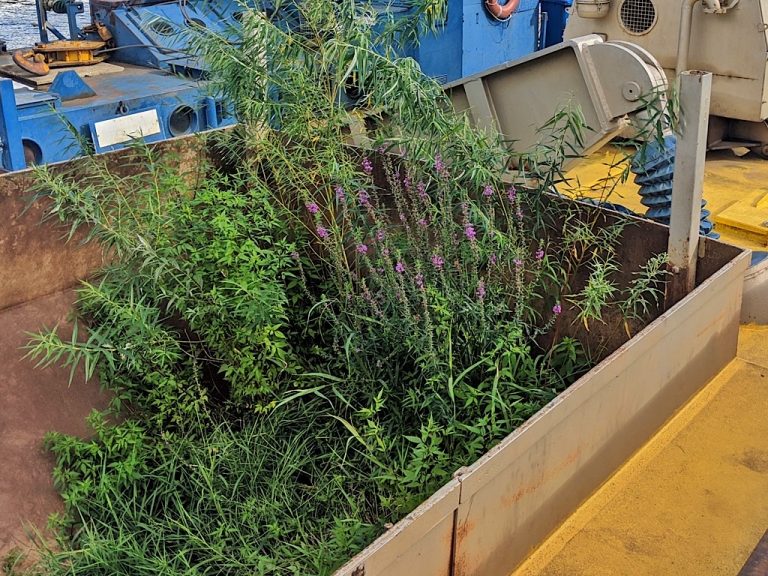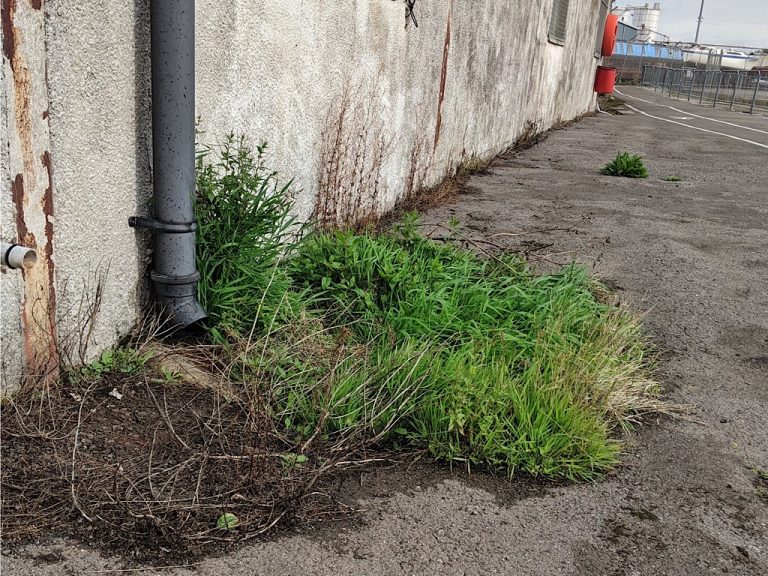
The accidental wetland gardens of Sharpness + inspiration for your garden from WWT

For a few years I have been observing how nature creeps into a concrete jungle – often spotted in unexpected places, not just the brownfield sites. Walking around the Sharpness docks last summer, a couple of new invasions caught my eye.
These were not just the odd adventurous plants here and there but mini wetland habitats. One is a pond created by trapped rainfall, the other is a micro bog created by a leaking down-pipe!
Look closer at the yellow boat in the foreground above and you will see a bushy garden growing at one end.
A rain fed pond with no drainage and no soil...
The flowering shrub in the boat above is Purple Loosestrife, a magnificent wild flower and water loving plant which grows by ponds and rivers. Purple Loosestrife can be seen on the river banks of both the Little Avon and the Pill near Berkeley.
Walking alongside the boat, it can be seen that the bottom of the boat has become a self established rainwater pond with a range of pond plants. No doubt there are a few creepy crawlies in there too.
The boat in the picture above I call ‘the banana boat’. Not because it ships bananas into Sharpness – arachnophobes can relax – but because it is painted yellow and in my photo below looks banana shape!
A panoramic view...
The bugs and flower seeds will attract birds. The bird poop will be a fertiliser and bring in more seeds. The leaves will drop in autumn and rot into compost and create more soil. The diversity of insect, fungi and microbes will expand and do their jobs.
And so the cycle of life goes on. Will a pioneer tree like Alder move in and eventually turn the wetland into dry land? Worms will get in there and improve the soil – they somehow seem to get everywhere! Or will a human clear the whole habitat away?
A bird's eye view...
This accidental pond shows how easy it can be to add a casual water feature to your garden. Even a tiny pond can provide vital drinking water to insects like butterflies and bees as well as birds. My mother’s garden pond was a plastic washing up bowl sunk into her garden, and a frog took up residence.
An old plastic bowl turns into a mini pond...
Not knowing where to put a wild iris I had dug up from the garden, I put it in an old washing up bowl and added some tap water. I lazily abandoned it in the shadow of the house for a few seasons and it became a thriving bog. Leaves fell into it – and no doubt other life which would look scary down a microscope moved in – but it never smelled bad at all. The iris even flowered – which it had never done before!
I did occasionally top up the bowl with water but it did dry out too at times. Generally, I forgot about it! If like me you don’t have anywhere for a water butt and have to use tap water, one tip is to stir the water vigorously in a bucket first and let it stand so the chlorine escapes into the air.
Very handily for the local frogs, our bowl pond was half way along their regular but risky ‘desert run’ from the garden to a small wall gap from which they come and go. We have even heard them snoring there! I left a large plastic tray against that wall and later found several frogs resting in this ‘tunnel’. So that tunnel is now a permanent feature.
The drip-drip of a leaking downpipe...
The second water garden was on the path goes alongside the north side of the Sharpness Dock’s large Tidal Basin and the shipyard. A leaking downpipe has created a damp patch of tarmac into which wild seeds have been able to germinate and grow and birds and stop for a drink.
Later I discovered on the WWT’s website that deliberately creating a ‘mini drainpipe wetland’ is actually a thing! Up-cycling a bowl or tub into a pond is recommended by the WWT too. More on how to do that below.
It's simple to make your own little pond or wetland...
It’s easy, cheap and needs little space. It’s environmentally friendly, fun to do, and can be sociable. What’s not to like about making a wetland in your own garden?
Then watch and enjoy as your garden attracts and benefits more wildlife – insects, birds, hedgehogs – including good pollinators or garden pest controllers. It’s a win-win situation! Though not for the ‘pests’.
What the Wildfowl & Wetlands Trust says...
WWT says:
“Making a wetland in your garden or community space can be easy, inexpensive, and brings many benefits to people and wildlife.
“You don’t need a huge garden or even diggable ground to make a wetland. Making a mini pond out of an old sink, metal tub, or a container under your drainpipe all make a difference and help increase biodiversity.
“A pond provides endless fascination to garden visitors of all ages with its cast of comic, dazzling or intriguing creatures, such as water boatmen, dragonflies, frogs and newts.“
WWT's ideas and tips for wetland gardening...
What & how guide
The WWT has some fantastic webpages with simple ideas, and info on how to easily create low or even zero maintenance ‘wetlands’ in your garden, however small.
As well as the container and downpipe garden ideas, with our weather and terrain, there is ample scope for the rain and bog garden ideas here in the Vale of Berkeley!
Upcycled container pond: “One of the best ways you can attract wildlife to your home, even if you only have a balcony, is to create a mini pond from a container. No matter how small, a pond will attract wildlife if it’s in good condition.”
How to make a mini wildlife pond from an upcycled container – WWT
Mini downpipe wetland: “Do you wish you had a pond, but don’t have the space? Here’s a great idea to turn your drainpipe into a mini-pond with built in water supply – you’ll have your very own wetland reserve. And it’s virtually maintenance free.”
How to build a mini downpipe wetland – WWT
Wildlife bog garden: “A bog garden is a fantastic and low-maintenance alternative to a pond. And if you’ve got a pesky part of your garden that always seems to collect water this is a fantastic way to use that space – creating something more attractive that provides wildlife habitat.” Plenty of such ‘pesky parts’ around here in Berkeley Vale, ha ha!
How to make a bog garden for wildlife – WWT
Rain garden: “Rain gardens are, at their simplest, shallow hollows that collect rainwater. What makes them different from ponds or bog gardens is that the water is allowed to drain away into the soil, so they will be dry when they’re dry and wet when it’s wet.”
How to make a rain garden – WWT
Wildlife pond: “Creating a pond is one of the most important things you can do for wildlife in your garden. It is vital habitat for wetland wildlife like frogs and dragonflies. It’s also great for many species of garden plant, insect, bird and mammal. …..Even in the most urban, concreted environment, a garden pond can be a mini-wetland, storing rainfall and releasing it slowly, which helps reduce the effects of heavy rainfall or long dry spells.”
How to build a wildlife pond – WWT
Other WWT gardening tips include:
Go peat free in your garden – WWT
Guide to choosing native pond plants – WWT
Invasive garden plant species – WWT
All the above links can also be found via the page: Gardening for wetlands – WWT






